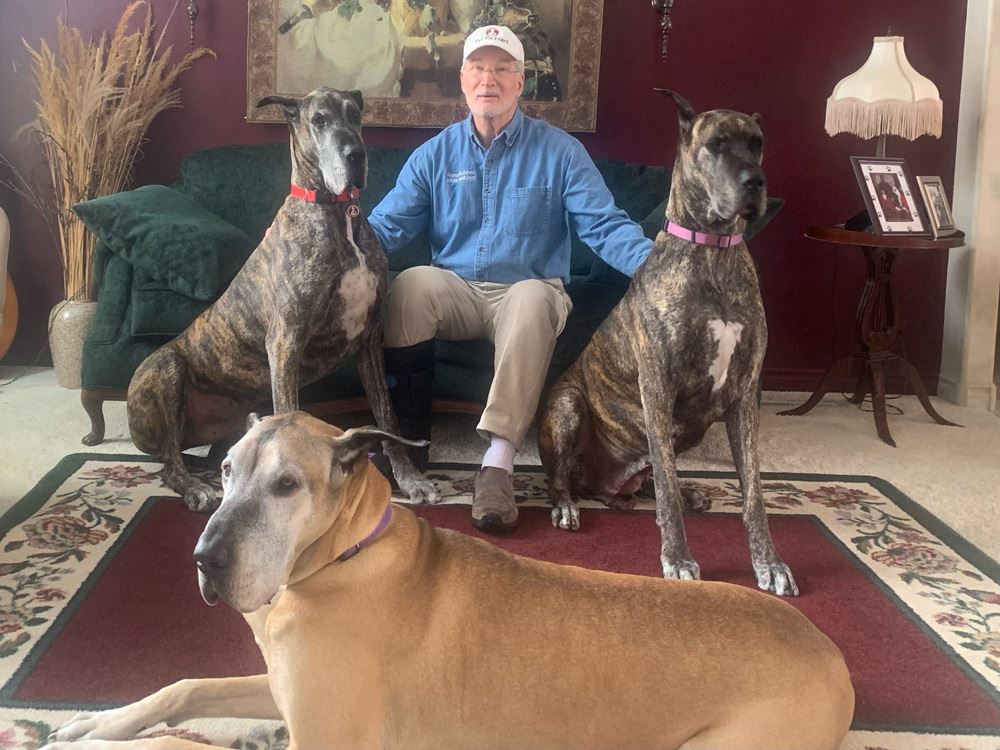Meet Hulu and Tootsie, Great Danes Volunteering at CentraCare – St. Cloud Hospital
They are not your typical CentraCare – St. Cloud Hospital volunteers. Hulu and Tootsie are the tallest among their peers, weigh upwards of 170 pounds each and walk on all fours. The pair are Great Dane Therapy Dogs that work with hospital patients once a week.
“When I come out of an elevator at the hospital, I always take a moment to check both ways because people don’t expect that size animal to be in the building,” shared the dogs’ owner and handler Wayne Chmelik.
Therapy dogs, also referred to as comfort dogs, help a person who may be going through mental, emotional or physical challenges. They help deliver a sense of calmness and restfulness to an otherwise stressful situation — not to be confused with working Service Animals or Emotional Support Animals (ESA).
“Lots of children will come up to me wanting to pet my dogs. Their parents often tell them not to because they think they are service dogs. I must tell them, that’s not correct. We want you to approach us if you’re comfortable,” Wayne affirmed.
Therapy dogs are trained to be obedient. To volunteer, they must go through extensive training for a variety of difficult situations and pass a test.
Wayne, Hulu and Tootsie visit patients at the hospital, like Rachel Koubsky’s 3-year-old daughter Nellie who was awaiting surgery.
“We requested a visit,” said Rachel. “But we didn’t know who was going to come. It was Hulu’s first day. They came in with a very large Great Dane,” she emphasized. “I was not expecting that, but he was so gentle. My daughter was in a lot of pain. It was just an awesome way to get her mind off that.”
Nellie confessed, “Hulu was sniffing … [it was] fun to see him!”
The pediatric patient repeated her mother’s words and proclaimed, “He was like eight of me!”
Wayne and his large dogs have become quite known throughout the CentraCare community visiting patients everywhere from those in rehabilitation to the people in the Intensive Care Unit.
“One day I was going into a room and there was a curtain drawn across the front of the door. I knocked, and the nurse jumped about two inches off the ground because she didn’t expect to see a huge Great Dane standing in the doorway,” chuckled Wayne.
The Great Dane’s handler started volunteering at the hospital after meeting Marlene Dingmann through Central MN Therapy Animal Association, an affiliate of the national organization Pet Partners. Marlene has logged over 3,000 volunteer hours with her own therapy dogs.
“My mentor, Marlene, and I were with Hulu on the adult mental health inpatient unit,” Wayne recalled. “It’s a locked facility and we had a patient referral. Hulu put his paw on the patient’s bed. I looked at Marlene wondering if it would be OK to let this 173-pound Dane crawl up there. The patient nodded her head yes and smiled, so I let him go. The next thing I knew, she was hugging him and tears started falling down her face. It was very touching.”
Marlene shared that patients aren’t the only ones who benefit from having therapy dogs in the facility.
“We’ve seen doctors come up to them that have had very stressful days. I’ve seen them get on the floor and play with the dogs. It’s so rewarding to see what therapy dogs can do for people.”
Hulu and Tootsie are only able to volunteer a maximum of two hours a day to avoid becoming overwhelmed and stressed.
“Sometimes we have 15 different referrals. I must choose which patients to visit because we have a limited amount of time,” Wayne avowed.
Wayne and Marlene feel it’s important to step back and let the therapy dogs create their own bonds with patients.
“I’ve always been a very social person,” Marlene insisted. “But the dogs need to do their thing. Sometimes people get bad news and just want a dog to pet. I’ve learned to be quiet in those situations.”
Wayne has witnessed his therapy dogs do things for people that humans simply can’t. He says it’s one of the most rewarding endeavors he’s ever taken part in.
“It’s emotional to watch. It’s that human and animal bond you just can’t describe. I see it in the patient’s eyes. That connection is so heartwarming — it really is.”
